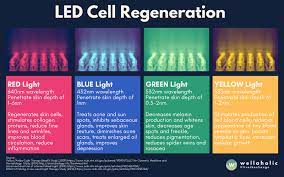Led Light Therapy Benefits

LED therapy has seen a led light therapy benefits recent resurgence in popularity, thanks in part to its many purported benefits. In this article, we will explore those benefits and detail how you can start using LED therapy to improve your health and well-being. From helping to alleviate pain to improving sleep habits, LED therapy has a lot to offer. If you’re interested in trying it out for yourself, read on for details on the best ways to get started.
If you’re looking for a way to improve your health and well-being, LED therapy may be the option for you. LED therapy is a form of light therapy that uses LED lights to treat various conditions. Popular uses for LED therapy include relieving pain, improving sleep habits, and reducing inflammation. In this article, we will explore the benefits of LED therapy and detail how you can start using it to improve your health.
What are the benefits of Led Light Therapy?
The use of LED light therapy has been shown to be beneficial in a variety of ways. One of the most commonly cited benefits is that it can improve mood and anxiety levels. Additionally, LED light therapy has been shown to help reduce pain and inflammation, improve sleep quality, and even improve vision.
What are the concerns with Led Light Therapy?
Some potential concerns with LED light therapy include the potential for adverse side effects, lack of evidence-based research, and the high cost associated with its use. Additionally, there is a limited number of studies investigating the long-term effects of LED light therapy, which makes it difficult to determine its full potential.
How does Led Light Therapy work?
LED light therapy is a form of Alternative Medicine that uses LED lights to treat a variety of conditions. The light therapy is based on the theory that certain types of light can help heal or improve the condition being treated.
There are several different types of LED light therapy, including standard blue and white LEDs, red and green LEDs, yellow LEDs, and infrared LEDs. Each type of LED has its own specific set of benefits and drawbacks.
Standard blue and white LEDs are the most common type used in LED light therapy treatments. These LEDs emit a warm, calming light that has been shown to reduce anxiety, stress, and inflammation. They are also effective for treating conditions like seasonal affective disorder (SAD), depression, insomnia, acne, psoriasis, eczema, and rosacea.
Red and green LEDs work differently than standard blue and white LEDs. They emit shorter wavelengths of light that are more stimulating for the body. This type of LED therapy is often used to treat conditions like ADHD, chronic pain syndromes (including fibromyalgia), migraines, post-traumatic stress disorder (PTSD), skin conditions like rosacea or eczema that are resistant to other treatments, neck pain caused by cervical compression syndrome (CPS),and varicose veins.
Yellow LEDs have a long history of use in Traditional Chinese Medicine (TCM). It is believed that they help reduce inflammation and calm the mind and body. Yellow
What are some potential side effects of Led Light Therapy?
Side effects of LED light therapy can include redness, itching, and dry skin. These side effects usually go away after a few days. If they don’t go away, contact your doctor. LED light therapy may also cause eye fatigue, headaches, and trouble sleeping.
Are there any long-term benefits to using Led Light Therapy?
There are long-term benefits to using light therapy for treating a variety of conditions, including sleep apnea, depression, and chronic pain. Light therapy is a form of treatment that uses LEDs or other forms of light to stimulate the body’s natural healing process.
Light therapy has been shown to improve sleep quality and duration in people with obstructive sleep apnea (OSA), as well as reduce symptoms of depression. In some studies, light therapy was also found to be more effective than prescription medications for treating depression.
There are several types of light therapy: phototherapy, which uses artificial sunlight; laser therapy, which uses a laser; and electric blue light therapy (EBLT), which uses short bursts of blue light. Each type has its own benefits and drawbacks.
Phototherapy is the most common type of light therapy used today. It involves exposing the skin to artificial sunlight or rays from the sun. This type of treatment is usually used to treat skin problems such as psoriasis or eczema. Phototherapy can also be used to treat OSA but may not be as effective as other treatments such as oral appliances or surgery.
Laser therapy uses a beam of energy from a laser pointer to target specific areas on the body. This type of treatment is often used to treat conditions such as wrinkles, acne scars, and unwanted hair growth in men and women. Laser Therapy can also be used to treat OSA but may provide less relief
Conclusion
If you’re looking to try out some new skincare products or to treat a specific condition, then LED light therapy might be the perfect solution for you. Not only is it non-invasive, but LED light therapy also has a number of benefits that can help improve your skin’s appearance and function. So if you’re curious about trying LED light therapy, be sure to browse our selection and find the perfect device for your needs.







